关于英语教学中情感教育文献综述
- 格式:wps
- 大小:74.16 KB
- 文档页数:6
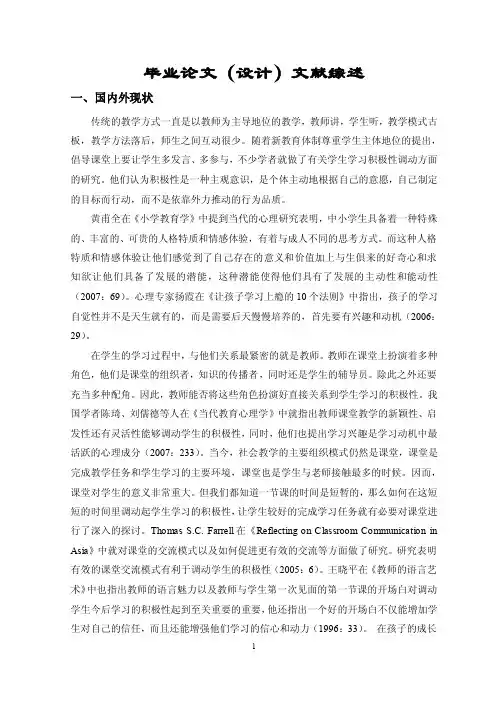
毕业论文(设计)文献综述一、国内外现状传统的教学方式一直是以教师为主导地位的教学,教师讲,学生听,教学模式古板,教学方法落后,师生之间互动很少。
随着新教育体制尊重学生主体地位的提出,倡导课堂上要让学生多发言、多参与,不少学者就做了有关学生学习积极性调动方面的研究。
他们认为积极性是一种主观意识,是个体主动地根据自己的意愿,自己制定的目标而行动,而不是依靠外力推动的行为品质。
黄甫全在《小学教育学》中提到当代的心理研究表明,中小学生具备着一种特殊的、丰富的、可贵的人格特质和情感体验,有着与成人不同的思考方式。
而这种人格特质和情感体验让他们感觉到了自己存在的意义和价值加上与生俱来的好奇心和求知欲让他们具备了发展的潜能,这种潜能使得他们具有了发展的主动性和能动性(2007:69)。
心理专家扬霞在《让孩子学习上瘾的10个法则》中指出,孩子的学习自觉性并不是天生就有的,而是需要后天慢慢培养的,首先要有兴趣和动机(2006:29)。
在学生的学习过程中,与他们关系最紧密的就是教师。
教师在课堂上扮演着多种角色,他们是课堂的组织者,知识的传播者,同时还是学生的辅导员。
除此之外还要充当多种配角。
因此,教师能否将这些角色扮演好直接关系到学生学习的积极性。
我国学者陈琦、刘儒德等人在《当代教育心理学》中就指出教师课堂教学的新颖性、启发性还有灵活性能够调动学生的积极性,同时,他们也提出学习兴趣是学习动机中最活跃的心理成分(2007:233)。
当今,社会教学的主要组织模式仍然是课堂,课堂是完成教学任务和学生学习的主要环境,课堂也是学生与老师接触最多的时候。
因而,课堂对学生的意义非常重大。
但我们都知道一节课的时间是短暂的,那么如何在这短短的时间里调动起学生学习的积极性,让学生较好的完成学习任务就有必要对课堂进行了深入的探讨。
Thomas S.C. Farrell在《Reflecting on Classroom Communication in Asia》中就对课堂的交流模式以及如何促进更有效的交流等方面做了研究。

情感教育在英语教学中的实施摘要:在教学过程中,情感教育的实施能够完善教学目标,增强教学效果。
本文结合笔者的教学实践对情感教育在英语教学中的实施进行了论述。
关键词:情感教育;师生关系;爱心;生活实际作者简介:沈宏勤,任教于河南省商丘市第十七中学。
影响教学质量的各种因素很多,通过十余年的教学摸索,笔者逐渐认为到:英语教学作为语言教学的一个过程,同时也是一个情感交流的过程。
教学中如果正确把握情感教育,既可以帮助塑造学生良好的品行,也能激发学生的学习兴趣,从而提高教学质量。
笔者通过情感教学,常能起到事半功倍的效果。
所谓情感教学从根本含义上说就是指教师在教学过程中,在充分考虑认知因素的同时充分发挥情感因素的积极作用,以完善教学目标,增强教学效果的教学,从而使认知因素和情感因素得到和谐的统一。
一、沟通情感教育的通行证--平等尊重现代教育提出教师是教学这个共同体中的首席,这就是说教师和学生是平等的关系,再不是以前的教师高高在上,而是要能够轻松地调动学生的兴趣,让他们积极主动地运用所学英语知识在创设的语境中参与自由交流,要向朋友一样平等对待他们,在课堂上教师既是良好的引导者,又是一个热心的、耐心的听众,还应该是一个谈得来的朋友。
良好的教学过程是师生相互沟通、相互交流从而增强师生情感交融,促进学生学习能力提高的过程。
教学中应树立民主平等的师生关系,创造和谐轻松的学习氛围,使学生对教师产生信任感、亲近感产、亲切感。
教师可轻松愉快地通过英语教学上的艺术性、形象性、趣味性揭示英语教材本身的魅力,达到调动学生的积极性和主动性。
在生活中,人们都很注重“第一印象”,其实,无论是对人还是对于学习,“第一印象”都非常关键。
开学伊始,学生对于教师、课程都很陌生。
笔者通过与学生亲切、平等的交流,取得了“双丰收”。
在开学最初,笔者先教学生一些简单的日常用语,如见面、道别、致谢、道歉、家庭成员的称谓、时间、年龄、性别等。
鼓励他们在适时、适当地使用这些用语,甚至当学生半中文、半英语夹杂着与笔者对话时,笔者也非常有耐心地与他们交流,消除他们对学习英语的恐惧感,打消他们的顾虑,让学生们感觉笔者与他们是平等的伙伴,而不是高高在上的“老师”,所以很快这些学生就对英语学习产生了浓厚的兴趣。
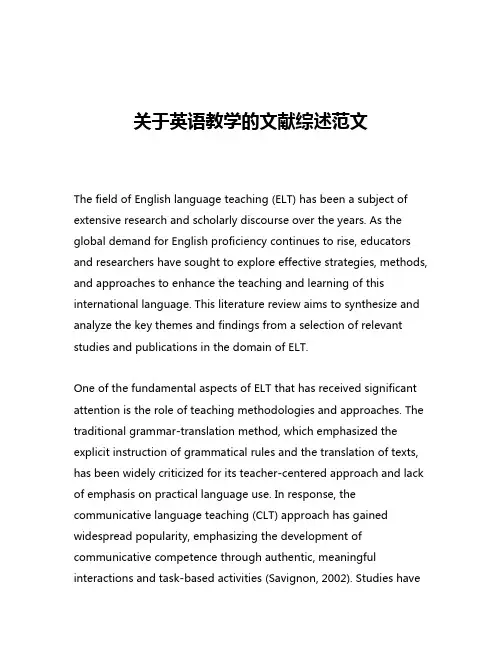
关于英语教学的文献综述范文The field of English language teaching (ELT) has been a subject of extensive research and scholarly discourse over the years. As the global demand for English proficiency continues to rise, educators and researchers have sought to explore effective strategies, methods, and approaches to enhance the teaching and learning of this international language. This literature review aims to synthesize and analyze the key themes and findings from a selection of relevant studies and publications in the domain of ELT.One of the fundamental aspects of ELT that has received significant attention is the role of teaching methodologies and approaches. The traditional grammar-translation method, which emphasized the explicit instruction of grammatical rules and the translation of texts, has been widely criticized for its teacher-centered approach and lack of emphasis on practical language use. In response, the communicative language teaching (CLT) approach has gained widespread popularity, emphasizing the development of communicative competence through authentic, meaningful interactions and task-based activities (Savignon, 2002). Studies haveshown that the CLT approach can lead to improved fluency, confidence, and overall language proficiency among language learners (Littlewood, 2014).Closely related to the discussion of teaching approaches is the concept of learner-centered instruction. Researchers have argued that effective ELT should prioritize the needs, interests, and learning styles of individual students, rather than adhering to a one-size-fits-all approach (Nunan, 1988). The incorporation of learner-centered strategies, such as differentiated instruction, project-based learning, and the use of technology-assisted language learning, has been found to enhance student motivation, engagement, and overall language development (Tomlinson, 2014).Another important area of focus in ELT research is the role of technology in language teaching and learning. The rapid advancements in digital technologies have significantly impacted the field of ELT, opening up new possibilities for language instruction and practice. Studies have explored the integration of various technological tools, such as online language learning platforms, mobile applications, and virtual classrooms, and their potential to improve language skills, enhance learner autonomy, and provide personalized feedback (Chapelle & Sauro, 2017).The issue of language assessment has also been a subject ofextensive research in ELT. Scholars have examined the effectiveness of different assessment methods, including formative and summative assessments, as well as the use of standardized language proficiency tests, such as the TOEFL and IELTS (Fulcher & Davidson, 2007). The importance of aligning assessment practices with the desired learning outcomes and the implementation of alternative assessment strategies, such as portfolio-based assessment and performance-based tasks, have been highlighted in the literature.The cultural and linguistic diversity of language learners is another crucial factor that has been widely discussed in ELT research. Scholars have emphasized the need to incorporate culturally responsive teaching practices, which acknowledge and validate the diverse backgrounds and experiences of language learners, and promote intercultural understanding and sensitivity (Canagarajah, 2005). Additionally, the role of the learners' first language (L1) in the ELT process has been a topic of debate, with some studies suggesting that judicious use of L1 can facilitate language learning, while others advocate for a more exclusive use of the target language (Cook, 2001).Finally, the professional development of ELT practitioners has been a crucial area of concern. Researchers have highlighted the importance of ongoing teacher training, collaboration, and the integration of research-informed practices to ensure the continuous improvementof teaching quality and student learning outcomes (Richards & Farrell, 2005). The exploration of teacher beliefs, attitudes, and reflective practices has also been a significant focus in ELT literature.In conclusion, this literature review has provided a comprehensive overview of the key themes and trends in the field of English language teaching. The findings from the various studies and publications discussed here underscore the complexity and multifaceted nature of ELT, as well as the need for a dynamic and evidence-based approach to language instruction. As the field continues to evolve, future research should explore emerging pedagogical strategies, technological advancements, and the changing needs and expectations of language learners in an increasingly globalized world.。

英语教学中情感教育理论研究论文英语教学中情感教育理论研究论文1教师知识水平的制约开展英语情感教学,需要教师了解学生的心理需求和变化,并适应新形式的不断变化,从而不断的丰富自身的英语知识结构,更好的为学生呈现丰富的学习内容。
在情感教学中要求教师具备高尚的品德、扎实的知识、一视同仁的心态等等,由于多方面因素的制约,在教学中存在很多教师还不满足情感教学的要求。
另外,教育科研机构也受到教育观念和环境的影响,对于英语情感教学重视程度较低,在教学指导方面并没有为老师和学生做出正确的引导,这在很大程度也影响着英语情感教学的发展。
2小学英语教学中情感教育理论的应用策略2.1建立和谐的师生情感关系开展英语教学活动的重要前提就是和谐的师生关系,同时也是提高教学质量和学生学习兴趣的重要方法。
在素质教育大的背景下,教师不仅仅是知识的传授者,更是教学活动中的参与者和引导者。
所以,教师要不断的转变自己的角色,做学生真正的朋友,了解学生的心理变化,了解学生的优点和缺点,平等对待每一位学生。
在教学活动中对于学生的不同表现,教师应及时的做出评价,并参与其中,感受学生的思想,这样也便于更好的开展下次教学活动。
另外,无论在课上还是课下,教师要走进学生,听取学生们提出的意见,并及时的做出调整,融洽的师生关系是需要教师用情感和爱去浇筑的,它可以消除学生在教学中产生的对立情绪和不良的心理,使学生可以真正的打开心扉,去接受教师所教授的知识。
教师真正的从内心身处去关心、爱护学生,公平、客观的对待每一名学生,才能够更好的建立和谐的师生情感关系。
2.2尊重学生个体差异,突出学生主体地位由于每个学生之间都有所不同,所以在他们自身智力水平以及学习能力的制约下,学生所表现出来的学习状态也是不同的,尤其是英语这种非母语语言学科而言,学生因情感因素而引起的学习兴趣恰恰是制约英语教学的关键。
在这种教学背景下,教师经常会将学分为“好学生”和“坏学生”,实际上这种做法是极其错误的,其不仅会加大英语教学的难度,更会对学生的情感上予以重创,从而使英语教学遇到困境。
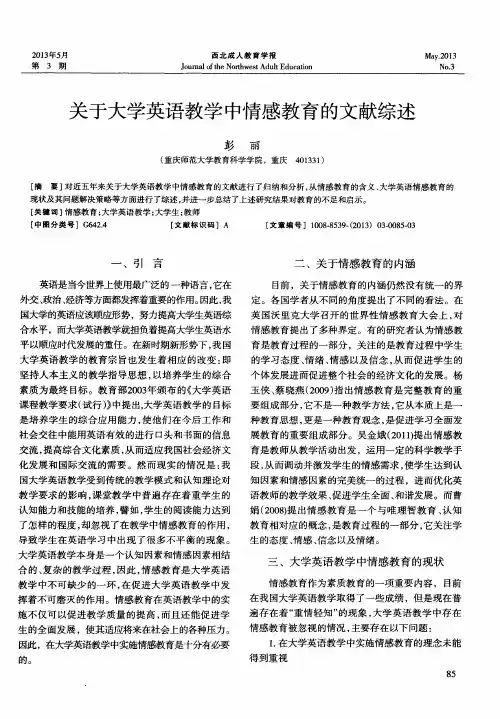
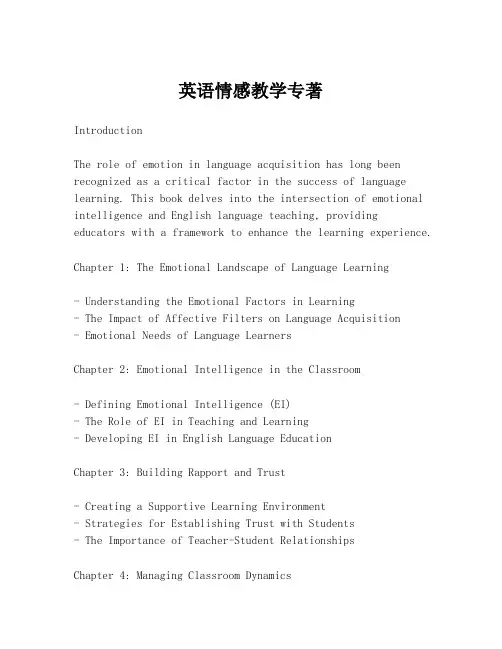
英语情感教学专著IntroductionThe role of emotion in language acquisition has long been recognized as a critical factor in the success of language learning. This book delves into the intersection of emotional intelligence and English language teaching, providing educators with a framework to enhance the learning experience.Chapter 1: The Emotional Landscape of Language Learning- Understanding the Emotional Factors in Learning- The Impact of Affective Filters on Language Acquisition- Emotional Needs of Language LearnersChapter 2: Emotional Intelligence in the Classroom- Defining Emotional Intelligence (EI)- The Role of EI in Teaching and Learning- Developing EI in English Language EducationChapter 3: Building Rapport and Trust- Creating a Supportive Learning Environment- Strategies for Establishing Trust with Students- The Importance of Teacher-Student RelationshipsChapter 4: Managing Classroom Dynamics- Addressing Emotional Challenges in the Classroom- Conflict Resolution Techniques- Encouraging Positive Peer InteractionsChapter 5: Incorporating Emotion in Teaching Strategies- Using Storytelling to Engage Emotions- Emotional Vocabulary and Language Functions- Role-Playing and Simulation ActivitiesChapter 6: Cultural Sensitivity and Emotion- Cross-Cultural Emotional Expressions- Teaching about Emotions in Different Cultures- Navigating Cultural Differences in the Classroom Chapter 7: Assessment and Feedback with Empathy- The Role of Empathy in Assessment- Providing Constructive Feedback Sensitively- Encouraging Self-Assessment and ReflectionChapter 8: Emotional Resilience and the Language Learner- Building Resilience in Language Learning- Coping with Language Learning Setbacks- Fostering a Growth MindsetChapter 9: Professional Development for Teachers- Enhancing Teacher EI through Professional Development- Reflective Practices for Teachers- Collaborative Learning and Peer SupportChapter 10: Future Directions in Emotional Language Teaching- Emerging Trends in Emotional Language Education- The Role of Technology in Emotional Learning- Preparing for Global Citizenship through Emotional IntelligenceConclusionThe integration of emotional awareness and intelligence in English language teaching is not just a pedagogical enhancement but a necessity for holistic learning. This book aims to equip educators with the tools to recognize, understand, and leverage the emotional dimensions of language learning to foster a more effective and empathetic classroom.Appendices- A: Emotional Intelligence Assessment Tools- B: Classroom Activities for Emotional Learning- C: Resources for Further Reading and Professional DevelopmentGlossaryReferencesIndexThis book is designed for English language teachers, teacher trainers, and educators interested in the role of emotions in the language learning process. It provides practical strategies and theoretical insights to help teachers create a more emotionally intelligent and effective learning environment.。

浅析情感教育在英语教学中的应用【摘要】在推进素质教育的今天,如何在有限的时间内,培养出适应未来社会的高素质的人才,是现代教学当中所必须解决的最根本的问题。
按照传统的教学方法,人们关注的往往是教学中的认知因素,而对情感因素则缺乏应有的重视。
这种失衡现象,违背教学活动的客观规律,自然要遭受到淘汰。
【关键词】情感教育英语教学应用在英语教学中应该重视情感领域的研究。
情感是一种潜在的动机,对人的行为具有激励、诱发和调节的重要功能,情感教育可以激发学生潜能和积极性,提高他们学习效率和成绩,近而大幅度提高英语教学质量。
一、情感原则良好的教学过程是师生相互沟通、相互交流,从而增强师生情感交融,促进学生学习能力提高的过程。
教学中应树立民主平等的师生关系,创造和谐轻松的学习氛围,使学生对老师产生信任感、亲近感、亲切感。
教师可轻松愉快地通过英语教学的艺术性形象性趣味性揭示英语教材本身的魅力,达到调动学生的积极性和主动性的目的。
比如在学生刚学英语时,先教学生一些简单的日常用语,如见面道别致谢、道歉、家庭成员的称谓、时间、年龄、性别等,鼓励他们适时适当地使用这些用语,甚至当学生半中文、半英语夹杂着与我对话时,我也非常有耐心地与他们交流,消除他们对学习英语的恐惧感,打消他们的顾虑,让学生们感觉我与他们是平等的伙伴,而不是高高在上的“老师”。
所以,这些学生很快就对英语学习产生了浓厚的兴趣。
情感与教学有着密切的联系,情感与科学的教学评价同样有着密切的关系,因为英语语言本身就是表达感情的工具,语言与人的心理发展、文明发展相联系。
另外,教师与学生从事教与学,都是带着情感的,而这种情感差异也导致了教与学的差异。
我们一直强调情感教学,也就是因为英语教学脱离不了情感。
在进行英语教学评价时,我们更要注意情感,注意人的心理体验。
评价学生时,不仅看他是否掌握了必要的英语基础知识,更要看他是否会用英语来表达自己的丰富感情。
同时,在评价学生时,教师要带着积极的情感来工作,关注学生的进步,善待学生,让学生从评价中获益,而不是受罚。
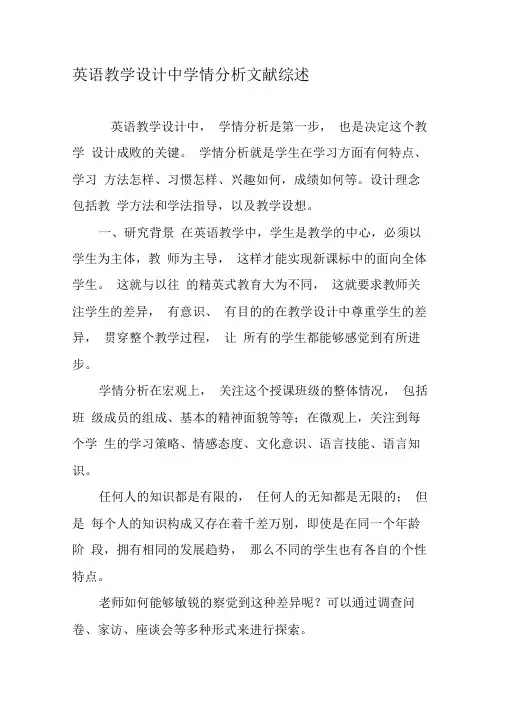
英语教学设计中学情分析文献综述英语教学设计中,学情分析是第一步,也是决定这个教学设计成败的关键。
学情分析就是学生在学习方面有何特点、学习方法怎样、习惯怎样、兴趣如何,成绩如何等。
设计理念包括教学方法和学法指导,以及教学设想。
一、研究背景在英语教学中,学生是教学的中心,必须以学生为主体,教师为主导,这样才能实现新课标中的面向全体学生。
这就与以往的精英式教育大为不同,这就要求教师关注学生的差异,有意识、有目的的在教学设计中尊重学生的差异,贯穿整个教学过程,让所有的学生都能够感觉到有所进步。
学情分析在宏观上,关注这个授课班级的整体情况,包括班级成员的组成、基本的精神面貌等等;在微观上,关注到每个学生的学习策略、情感态度、文化意识、语言技能、语言知识。
任何人的知识都是有限的,任何人的无知都是无限的;但是每个人的知识构成又存在着千差万别,即使是在同一个年龄阶段,拥有相同的发展趋势,那么不同的学生也有各自的个性特点。
老师如何能够敏锐的察觉到这种差异呢?可以通过调查问卷、家访、座谈会等多种形式来进行探索。
1.学情分析是教学设计的前提和基础教师在开展教学设计时,考虑的主要因素包括:课程标准、教材内容、学生情况、教学方法、课程资源等。
其中,学情分析既是教学目标设定的基础,又是教学内容解析的依据,还是教学策略选择与学习活动设计的落脚点。
总之,学情分析是对“以学定教”课改理念的具体落实。
依据现代教学设计理论,教师必须认真研究学生的已有知识、实际需要、能力水平和认知倾向,才能更有效地优化教学设计,达成教学目标,提高教学效率。
因此,“学情分析”应当成为教学设计的必要前提。
2.学情分析是精准实施课堂教学的关键要素美国著名教育心理学家奥苏伯尔曾经指出:“如果我不得不将教育心理学还原为一条原理的话,我将会说,影响学习的最重要的因素是学生已经知道了什么,我们应当根据学生原有的知识状况进行教学。
”根据学生原有的知识状况进行教学,不仅在课前要深入分析学生知识层面上、解决问题水平上的“最近发展区”,更需要在课堂教学中及时观察学生的学习表现,了解学生的思维状态,及时调整教学行为、教学环节和教学进程,针对难点、疑点和关键点教,针对学生提出的问题教,针对生成的有价值的问题教。

(本科)毕业论文浅谈英语对中学生情感教育的培养系别:外语系专业:英语专业班级:学号:学生姓名:指导教师:完成时间:年月独创性声明本人郑重声明:所呈交的题为《浅谈英语对中学生情感教育的培养》的毕业论文(设计)是本人在指导老师指导下取得的研究成果。
除了文中特别加以注释和致谢的地方外,论文(设计)中不包含其他人已经发表的研究成果。
与本研究成果相关的所有人所做出的任何贡献均已在论文(设计)中作了明确的说明并表示了谢意。
学生签名:年月日授权声明本人完全了解有关保留、使用本科生毕业论文(设计)的规定,即:有权保留并向国家有关部门或机构送交毕业论文(设计)的复印件和磁盘,允许毕业论文(设计)被查阅和借阅。
本人授权许可以将毕业论文(设计)《浅谈英语对中学生情感教育的培养》全部或部分内容编入有关数据库进行检索,可以采用影印、缩印或扫描等复制手段保存、汇编论文(设计)。
学生签名:指导教师签名:年月日浅谈英语对中学生情感教育的培养摘要:英语作为一种语言性交流手段,也是作为国际对外交流手段,情感教育的培养是语言交流和国际对外手段必不可少因素之一。
随着社会教育快速发展,英语遍及各个中学也凸显各种问题,情感教育的需要在中学教育已迫在眉睫。
本文以中学为例,通过发现英语在中学出现的问题进行全面的研究和探讨去发现中学英语教师对情感教育存在一定问题,如:教学中没有“以学生为主,教师为辅”的教学原则以及让学生“学以致用”,没有更好调动学生积极性和利用多种方式教学等多种问题,这严重阻碍了中学生学习的向前发展,也阻碍了情感教育的健康发展,本文再从完善中学情感教育,提高中学生学习英语效率,保证中学教师教学质量等方面提供相关策略和解决办法。
关键词:中学生;英语教学;情感教育;情感教育培养ABSTRACT:English as a means of language communication, and as an international means of foreign exchange, the cultivation of emotional education is one of the essential factors of language communication and international external means. With the rapid developing of social education, English in all middle schools also cause a variety of issues, the need for emotional education in middle education is imminent. Taking the middle school as an example, through the discovery of English in the middle school problems are studied and discussed comprehensively to find the middle school English teachers has some problems, such as: Teaching of emotional education is not "student-centered teaching principle, supplemented by the teacher" and let students "learn to use", there is no better mobilize the enthusiasm of the students and the use of a variety of ways of teaching and other problems, which seriously hindered the development of students' learning, but also hinder the healthy development of emotional education, this article from the perfect middle school emotional education, improve the students' English learning efficient, provide relevant solutions and strategies on middle school teachers' teaching quality.Key words: middle school students; English teaching; emotional education; Emotional education to cultivate目录引言 (1)一、实施情感教育的背景 (1)(一)现代教育存在的问题 (1)(二)语言教学所决定 (1)(三)中学生对英语重视不够 (2)二、情感教育在中学英语实施原因 (2)(一)《中学英语课程标准》的要求 (2)(二)情感教育理论依据 (3)三、情感教育的功能 (3)(一)启智功能和感染功能 (3)(二)健身功能和迁移功能 (4)四、初中英语教学中情感教育存在的现状 (4)(一)责任感培养的缺失 (4)(二)学生自信心的忽略 (5)(三)缺乏真实语言环境 (5)(四)英语教师教学方法单一 (5)五、解决情感教育的相关策略 (6)(一)增强责任感的培养 (6)(二)增强学生自信 (6)(三)创设真实语言环境 (7)(四)完善英语教学方法 (7)六、情感教育的具体意义和运用 (8)(一)利于培养中学生积极情感 (8)(二)情感教育在英语教学中的运用 (10)七、结束语 (11)参考文献: (11)致谢 (12)引言情感教育,即所谓中学生必须接受的一门教育,也是精神上的一种教育。
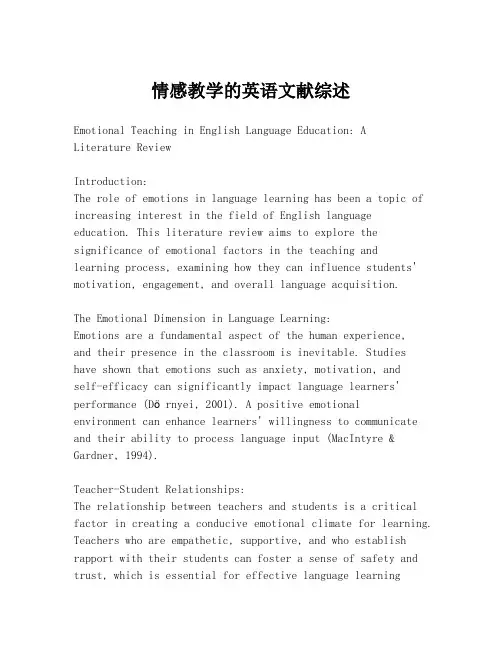
情感教学的英语文献综述Emotional Teaching in English Language Education: ALiterature ReviewIntroduction:The role of emotions in language learning has been a topic of increasing interest in the field of English language education. This literature review aims to explore the significance of emotional factors in the teaching andlearning process, examining how they can influence students' motivation, engagement, and overall language acquisition.The Emotional Dimension in Language Learning:Emotions are a fundamental aspect of the human experience,and their presence in the classroom is inevitable. Studies have shown that emotions such as anxiety, motivation, andself-efficacy can significantly impact language learners' performance (Dörnyei, 2001). A positive emotionalenvironment can enhance learners' willingness to communicate and their ability to process language input (MacIntyre & Gardner, 1994).Teacher-Student Relationships:The relationship between teachers and students is a critical factor in creating a conducive emotional climate for learning. Teachers who are empathetic, supportive, and who establish rapport with their students can foster a sense of safety and trust, which is essential for effective language learning(Nikolov, 2001).Classroom Atmosphere:A classroom atmosphere that is characterized by mutual respect, encouragement, and a focus on the learning process rather than just the outcomes can reduce learners' anxiety and increase their motivation (D örnyei, 2002). The use of cooperative learning strategies can also contribute to a more positive emotional climate by promoting peer support and collaboration.Emotional Intelligence in Teachers:Teachers with high emotional intelligence are better equipped to manage their own emotions and to respond effectively to the emotional needs of their students (Zeidner, 1998). They can use their emotional intelligence to create a more inclusive and empathetic learning environment, which can lead to improved language learning outcomes.Coping Strategies for Emotional Challenges:Learners need to develop coping strategies to deal with the emotional challenges they face in language learning. Techniques such as deep breathing, visualization, andpositive self-talk can help learners manage test anxiety and performance stress (Oxford, 2009).Conclusion:Understanding and addressing the emotional aspects of language learning is crucial for English language educators. By creating a supportive and positive learning environment, fostering strong teacher-student relationships, anddeveloping emotional intelligence, educators can help learners overcome emotional barriers and enhance their language learning experience.References:- Dörnyei, Z. (2001). Teaching and Researching Motivation. Harlow, UK: Longman.- MacIntyre, P. D., & Gardner, R. C. (1994). The subtle effects of language anxiety on cognitive processing in the second language. Language Learning, 44(2), 283-305.- Nikolov, M. (2001). The affective filter in the classroom: Effects of teacher-student rapport. TESL Canada Journal,18(2), 42-68.- D örnyei, Z. (2002). The role of personality in second language acquisition. Language Learning, 52(1), 1-30.- Zeidner, M. (1998). Test anxiety: The state of the art. Psychological Bulletin, 123(2), 165-185.- Oxford, R. L. (2009). Toward a psychology of well-being for language learners: The “EMI” approach. In A. D. Cohen & E. MacIntyre (Eds.), Language learner strategies (pp. 89-104). Amsterdam, Netherlands: Emerald Group Publishing Limited.。

探索有关情感教育的文献综述探索有关情感教育的文献综述导读:自我意识的不断增强,他们生理、心理发生巨大的变化,迫切需要父母、朋友、老师和同学的理解和关心.而情感教育在这方面满足了青少年学生成长的需要,帮助青少年学生发展成为完整的人.一、情感教育的内涵和特点情感是指人对于客观现实的态度和体验,它是由客观事物是否满足个体的需要而产生的.情感教育是一个与认知教育相对应的有关情感教育的文献综述摘要:情感教育是世界六种著名的教育方法之一,它是完整教育的一个重要组成部分,对于学生全面的发展具有重要的作用.本综述从对情感教育的认识、概念和特点,情感教育的原则和功能,情感教育实施的途径等方面阐述,从国内外实施情感教育的情况,了解情感教育存在的问题以及对策.关键词: 情感教育完整教育问题及对策面对21世纪经济社会的迅猛发展,社会格局发生翻天覆地的变化,社会的人才培养要求也在发生变化,学校教育培养人的任务也变得日益复杂.作为新课程改革下的教育者,应该如何引导学生、激励学生,教育学生和培养学生面对现实社会,适应社会?怎么帮助学生树立正确的人生观、价值观,成为社会需要的人才?这些问题值得教育者应该理性的思考和探索.青少年学生正处于个体发育、发展的最宝贵时期,随着个体自我意识的不断增强,他们生理、心理发生巨大的变化,迫切需要父母、朋友、老师和同学的理解和关心.而情感教育在这方面满足了青少年学生成长的需要,帮助青少年学生发展成为完整的人.一、情感教育的内涵和特点情感是指人对于客观现实的态度和体验,它是由客观事物是否满足个体的需要而产生的.情感教育是一个与认知教育相对应的概念,它是指把情感作为人的发展的重要领域之一,对其施以教育的力量【1】.从本质上讲,情感教育是完整教育的一个重要组成部分;从内涵上讲,它不是一种教育方法,而是一种教育思想,一种教育观念.它倡导人本主义心理学家罗杰斯;以人为本;的教育理念,关爱学生、以学生为本、对学生进行情感的陶冶成为情感教育的核心.实施情感教育,即在教育过程中要尊重和培养学生的社会性品质,提高其自我调控的能力,促进其对自我、环境以及两者之间的关系产生积极的情感体验,形成独立健全的人格特征【2】.情感教育包含三个方面的内容:道德感、理智感和美感.道德情感是把青少年学生的道德认识转化为道德行为的中间环节.在日常生活中,我们经常可以看到许多学生由于缺乏道德情感,而做一些不道德的行为,但是由于他们缺乏道德情感的体验与约束,因为他们并没有意识到自身的不道德行为,也没有受到内心的谴责.因为对学生进行情感教育,需要培养学生道德情感,提高道德情操和个人修养.理智感是与认知活动相联系的情感,是在认识过程中产生的一种情感体验.它是学生对未知事物和现象的探索的,是推动学生积极学习,追求真理的内在力量.列宁说过:;没有人的感情,就从来没有,也不可能有人对真理的追求.;可见,理智感在学生成长成才过程中起着不可或缺的作用.培养青少年学生热爱生活、欣赏世界的美好不能缺少美感.美感是一种审美的情感,是人们按掌握的审美准则评价自然、社会及艺术作品时所产生的情感体验.我国的教育目标是培养德、智、体、美、劳全面发展的社会主义接班人.学生缺乏对美的认识,缺乏对美的追求,难以成为全面发展的人,难以成为一个完整的人.美就是在发现美、表现3 4 5探索有关情感教育的文献综述导读:美、创造美的过程中,使美的情感得到升华,转变为美的行动,从而激发学生的求知欲,形成良好的个性习惯,达到情感良性循环的目的.情感教育有以下几个特点【3】:第一,情感的感染性.就是以情动情,使相互之间产生情感上的共鸣.第二,情感的积累性.从小事做起,对学生表达班主任的爱,日积月累,让学生产生情感上的触动.第三,情感的弥散性.就是以情,唤起学生全身心的爱.第四,情感的移情性.就是情感的迁移,使学生对班主任的感情移情到所学的课程上,不断提高学习成绩.二、国内外情感教育的发展情况情感教育的发展,源远流长.它可以追溯到柏拉图时期的心灵教育,亚里士多德时期倡导的自由教育、;博雅;教育,罗杰斯的人本主义情感教育以及苏霍姆斯基的情感动力思想.在近代英国,情感教育被理解为快乐教育和体谅教育.当代英国著名教育家尼尔认为,当今有很多学校只重视知识的学习,忽视情感教育.事实上,情绪、情感对人的影响远比智力大,没有比情感更重要的了.因而尼尔的办学思想是:尊重生命,尊重个性.他认为生命的意义在于追求幸福、寻找兴趣.教育是为人生做准备的,不能只把教育看做考试、学问和班级.教育的目的是适应学生,不是学生来适应学校.成功的标准是工作愉快和生活积极【4】.因而,不少教育家预言,快乐教育将代表21世纪人类的教育精神.体谅教育的基本思想是多关心、少评价.它是20世纪60年代兴起的一种以培养道德情感为注的教育方式.它的宗旨是使学生摆脱不良行为.美国的情感教育从最初的情感教育起源,到当今的表现形式都与职业指导紧密相关.它开展的情感教育课程的目的是促进情感发展,增进个人适应社会的能力.美国情感教育的模式在世界上有着广泛的影响.在其他一些国家,如西班牙、丹麦等,情感教育通过激励,提供学生一个安全的空间,让他们的智力、社交与情感方面能够得到充分的尊重和发展,从而塑造他们的个性,并发展成熟的价值观.我国古代教育家事以;社会治平;为终极目标,崇尚个人理想人格的塑造.他们主张真、善、美统一于一体.|在近代中国,如蔡元培、陈鹤琴、陶行知等老一辈教育家在主张科学教育之外,还倡导情感教育.其中,陈鹤琴还提出的;一切为了孩子,为了孩子的一切;教育信条影响了一代又一代的父母、家长、教育者.在中国,情感教育又被誉为感化教育、成功教育、快乐教育和爱的教育.三、实行情感教育的策略.情感教育的原则就是以人为本,情智相融,和谐共生【5】.它实行的策略有以下几个方面: (1)以理育情.俗话说;知之深,爱之切;,为了培养学生积极的情感,就必须让他们了解有关的知识,懂得有关的道理.知识越丰富,道理越深刻,情感就会越深厚、崇高.学生在教师传授学习经验的过程中,得到情感的熏陶、激发、感染和引导,从而让学生树立正确的是非观、道德观.(2)以智育情.教师应该教会学生从挫折中站起来,理智地对待生活中各种各种的挫折和不幸,增强社会适应 3 4 5探索有关情感教育的文献综述导读:的情操和修养.教师具有开朗、乐观、积极、宽容的品性,会无形中感染学生的性情.教师要善于发现学生的情感体验,帮助学生克服不良的性格缺陷,培养开朗的性格和达观的情怀.(5)以情育情.马克思说:教育绝非单纯的文化传递.教育的核心是一切人格心灵的;唤醒;【6】.现在的学生大部分是独生子女,个性强,不爱学习,难教育,教师需要在充能力,以乐观积极的态度面对未来.通过让学生树立目标,了解学生的;心里话;,引导学生地评价自我,以保持最佳的情感状态.(3)以导育情.为了给学生增加学习活动的积极情感体验,教师需要引导学生向控制内在化方面发展.增加学生对事物因果关系的认识,对生活中真实或假设性的事情进行分析和讨论,对个别特殊的学生还需要进行具体的指导,及时地对他们学习上的进步给与鼓励.(4)以性育情.教师对学生进行情感教育,首先是教师自身有高的情操和修养.教师具有开朗、乐观、积极、宽容的品性,会无形中感染学生的性情.教师要善于发现学生的情感体验,帮助学生克服不良的性格缺陷,培养开朗的性格和达观的情怀.(5)以情育情.马克思说:教育绝非单纯的文化传递.教育的核心是一切人格心灵的;唤醒;【6】.现在的学生大部分是独生子女,个性强,不爱学习,难教育,教师需要在充分了解学生的基础上和学生进行心灵的沟通,唤醒他们的聪明才智,增强他们的自信心,调动他们的积极性,从而达到;魏书生;式的自主管理、自发学习的教育境界.总之,对于学生来说,教师的情感感染力不仅是一种间接的、无形的情感培养,而且是一种培养学生情感的心理力量.(6)以行育情.无声的爱的教育是点燃学生心灵情感的火花.教师的人生观、价值观、工作责任感和敬业精神对学生的影响最为直接,教师要处处以身作则,言传身教,以高尚的品格感染学生,培养他们良好的品德【7】.(7)以书育情.阅读在培养学生情感方面有着特殊的功能,读书不仅可以使学生获得广博的知识,而且也是培养情感的丰富性和深刻性的重要途径.作为一所学校,第一件事就得有书籍.教师鼓励学生广泛阅读,并交给阅读的方法,激励学生,从中不断汲取营养,培养其深刻而丰富的情感.(8)以境育情.培养学生积极的情感,应当通过开展丰富多彩的活动来创设情境,做到以境育情.形式多样的活动可以提高学生的自豪感、荣誉感、集体主义情感,让学生在真实的情境中获得强烈的情感体验,唤起对生活、对美的追求.四、情感教育的功能我国有句俗语;人非草木,孰能无情;,意思就是只要你动之以情,晓之以理,总会感动他人的.许多成功的教育家在总结人才培养时,都会提到;以情感人,以情动情;.我国的教育家夏丐尊先生把教育和情感的关系,比喻为池塘和水的关系,指出:没有情感,没有爱,也就没有教育【8】.因此情感教育的功能有以下几个方面.(1)有利于增强师生间凝聚力【9】.学生进行情感教育,可以建立师生之间的相互信任和关心.信任是人际交往的基石,相互之间的信任,会赢得彼此的沟通和理解.教师对学生进行富有人情味的教育,倾听学生的心声,关心和爱护学生.心理学研究表明:如果教师对学生关爱、信任,就会帮助学生进步;反之,对学生冷淡、歧视等,则极有可能使学生走向反面.师生间相互建立融洽的关系,有利于增进学生与老师的相容性,有利于增强班集体之间的凝聚力.(2) 3 4 5探索有关情感教育的文献综述导读:学率,容易导致学生发展的片面化,不利于学生德、智、体、美、劳的全面发展.学生认知功利化,怎么成为合格的中国特色社会主义事业接班人呢?(2)社会上存在一种;唯理智教育;,这种教育类似于应试教育,虽然这种教育倾向遭到许多批评,但是在现代仍然有其牢固的思想根基和现实根基.这种教育思想忽视学生情感,以知识的获得和智力的开可以增强学生自信心,促进学生潜能开发.情感教育可以促进学生客观认识自己,评价自己.教师运用情感教育的原理,尊重学生、欣赏学生,给与学生更多的关心,可以增强学生的自信心.(3)有利于完善学生品德.人的高尚思想品德不是天生就有的,而是在一定社会关系和社会情境中习得的,是在与别人的交往中内化的.教师在运用情感作用完善学生品德可以通过角色倒置、意外效应、超常信任来达到效果.(4)有利于学生培养理智感、美感,促进学生成才.五、关于情感教育存在的一些问题与反思存在的问题(1)随着社会的快速发展,现实的教育是片面强调教育目标的工具价值而忽视情感教育促进人全面发展的精神价值和人文价值,应试教育虽然进化成为了素质教育,但是社会化的大趋势,将教师、学生的认知兴趣和情感引向功利主义.教师的功利化,往往会忽视学生情感发展的需要,片面追求升学率,容易导致学生发展的片面化,不利于学生德、智、体、美、劳的全面发展.学生认知功利化,怎么成为合格的中国特色社会主义事业接班人呢? (2)社会上存在一种;唯理智教育;,这种教育类似于应试教育,虽然这种教育倾向遭到许多批评,但是在现代仍然有其牢固的思想根基和现实根基.这种教育思想忽视学生情感,以知识的获得和智力的开发为主要目标,严重的扭曲和阻碍了学生身心的健全发展,割断师生的情感交流,造成学生缺乏爱的教育,思想萎靡.(3)封建传统思想作祟.我国历史悠久的文明为人类的进步做出了巨大的贡献,但是2000多年的封建教育腐蚀着人们的思想.很多中国人,特别是老一辈的人,无法从封建社会遗留下的泥潭里走出来,仍然记得;教鞭教育;、;戒尺教育;、;惩罚教育;……我们提倡对学生进行情感教育的口号,已经喊了好多年了,却仍然无法革新一些教育者的思想.现代社会讲求尊重学生、关爱学生、走进学生的内心世界,逐渐从对学生的惩罚教育中走向情感教育.当代著名的教育改革家魏书生,充分运用以人为本的思想,关爱学生、教育学生,通过与科学的教育思想,在了解学生生理、心理特点的情况下引导学生进行自我教育、自我管理【10】.他信任他的学生,关爱他的学生,笔者认为这种;魏书生;的班级管理思想是值得推崇的.因为它也是运用到了情感教育的思想和原理,并在情感教育的指导思想上做了革新和完善.对情感教育的反思(1)笔者认为现代教育现象中倡导的一些赏识教育、愉快教育、体谅教育和感化教育等都是出自于教育者对学生发自内心的爱的教育,它与情感教育的本质一样或者从属于情感教育.以学生为本,关爱学生,尊重学生,通过动之以情、晓之以理的教育方式,处在学生的角度设身处地为学生着想.(2)笔者认为实行情感教育并不是对学生没有;惩罚;,教育现象中出现一种;良性惩罚;的口号声,我认为这与时代的发展不无关系.报纸、新闻上我们可以常常看到一些学生伤害老师的事件,我想首先应该反省的是老师.如果老师尊重学生、关爱 3 4 5探索有关情感教育的文献综述导读:到的:犯错误,写心理病历;犯错误,做好事等等.这些;良性惩罚;不但没有伤害学生自尊,还可以让学生从;惩罚;中体验到情感教育的熏陶.(3)情感教育对班级文化的营造和管理有和重要的作用.人总是生活在一定的文化环境中的,文化无时无刻不对人产生影响【11】.情感教育也有文化价值.情感文化的传递是通过三个方式进行的.其一是后喻式学生,对学生进行情感教育,我想学生是不会轻易伤害老师的.其次,是对学生的;惩罚;.老师对学生的惩罚要质,也要度.例如,魏书生老师在班级管理里提到的:犯错误,写心理病历;犯错误,做好事等等.这些;良性惩罚;不但没有伤害学生自尊,还可以让学生从;惩罚;中体验到情感教育的熏陶.(3)情感教育对班级文化的营造和管理有和重要的作用.人总是生活在一定的文化环境中的,文化无时无刻不对人产生影响【11】.情感教育也有文化价值.情感文化的传递是通过三个方式进行的.其一是后喻式情感教育,即由年长者向年幼者传递情感经验, 使原本外在于年幼者的社会情感得以内化.其二是前喻式情感教育, 指按自下而上的方向由年幼者向年长者传授情感经验; 其三是同喻式情感教育, 指情感按同龄人互动的方式传递, 同辈群体成员之间相互传授情感经验【12】.班级形成良好的文化氛围,有利于培养学生的责任感、集体感,有利于学生之间团结友爱,形成积极向上的班级精神.(4)社会呼唤情感教育,学生呼唤情感教育.作为未来的父母、教育者,我们应该倡导情感教育,尊重学生,关爱学生,以学生为本.参考文 3 4 5。
情感教育在高中英语教育中的应用分析张萍摘要:高中时期的教育最受关注,因为它是青少年身心能否得以健康成长的关键时期。
将情感教育融入高中英语教学,可以帮助学生更好地学习文化课程,也能够帮助学生形成正确的人生观,这时学生就能以端正的态度投入学习,从而提升学习成绩。
在高中英语教学中,教师要注意情感教育的渗透策略,以促进学生的全面发展。
关键词:高中;英语教学;情感教育引言在高中英语课堂教学中,如何渗透情感教育并引导学生积极、热情、主动参与课堂活动,是提高英语课堂教学效果的一个重要方面。
通过自己近几年不断的英语教学实践,我发现对于我校的学生,情感的培养是激发学生学习英语兴趣和动机的重要方面,只有在课堂教学中注重学生的情感教育,才能提高英语教学效率。
下面将结合本人的教学实践,谈谈自己的点滴体会。
1英语教学现状及融入情感教学的必要性分析英语是一门语言类科目,对学生的听说读写都有要求,这就给教师的教学增加了难度,也给学生的学习过程造成了困难。
在当前的英语教学过程中,一些教师过于重视应试教育,将提升学生的成绩作为主要教学目标,这一做法忽视了学生的实际能力培养,并且教学过程十分枯燥,长此以往,学生就会出现注意力不集中的情况,并失去对英语学习的兴趣。
这种教学方式在很大程度上降低了学生学习的积极性,而情感教育模式能够弥补这一弊端。
实践证明,情感教学方法不仅可以加强教师与学生在课堂中的沟通,营造积极的课堂氛围,提高学生对英语学习的兴趣,还能进一步提升学生英语学习的综合效果。
本文在对当前英语教学现状进行分析的基础上,对情感教育模式进行了具体阐述,并且结合情感教育模式对高中英语的发展提出可行性的建议。
情感教学是将学生的兴趣、自信、动机以及合作精神等因素通过课堂教学进行激发,提升学生的情感状态,激发学生的学习动机,使之对学习产生浓厚的兴趣。
积极的情感教学对学生的学习发挥着十分重要的作用,而消极的情感教学则适得其反,会让学生丧失学习兴趣,还会对学生的学习效果产生直接的负面影响。
关于《英语教学中的情感教育》的文献综述一.前言学校教育是教师和学生共同参与的双边活动,也是在特定情境中的人际交往活动。
教育教学活动中师生之间不仅有认知方面的信息传递,而且也有着情感方面的信息交流。
在英语教学中,情感即是英语教学的手段也是英语教学的目的。
《普通高中英语课程标准》明确指出“积极情感如爱好、动机、自信、意志和协作精神等是影响学生学习过程和学习效果的重要因素。
教师应在教学过程中,不断激发并强化学生的学习爱好,并引导他们逐渐将爱好转化为稳定的学习动机,以使他们树立自信心,锻炼克服困难的意志,熟悉自己的学习优势与不足,乐于与他人协作,养成和谐和健康向上的品格。
”新课程强调情感不仅指学习兴趣、学习热情、学习动机,更是指内心体验和心灵世界的丰富。
情感还是课程目标的重要组成部分,是课程教学的手段和方法。
因此教师必须在教学过程中进行有意识的渗透,使之贯穿于教学过程之中,成为课程教学内容的血肉和灵魂。
可见,实施英语情感教学,培养学生积极的情感,消除消极的情感,促进学生健全人格的发展,就成了英语教学中有待解决的重要课题。
本文就此做些初步探讨。
二.英语情感教学的实施列宁说过:“没有人的情感,就从来没有也不可能有对真理的追求。
”在英语教学中,情感既是教学的目标之一,又是教学的手段之一。
情感教育是素质教育不可缺少的重要层面,对学生的全面发展有着重要的作用。
师生之间的情感交流的程度直接影响教学的成败。
人文主义强调以人为本,尊重人,满足人的发展需要。
随着教学改革的深入,人们越来越认识到情感在英语教学中的地位,强调关注每个学生的情感,激发他们学习英语的兴趣,帮助他们建立学习的成就感和自信心,使他们在学习过程中发展综合语言运用能力,提高人文素养,增强实践能力,培养创新精神。
但如何才能在英语教学中更好地实施情感教学呢?(一)身体力行,以情感人前苏联教育学家马卡连柯在《关于我的经验》中写到:"教育技巧也表现在教师运用声调和控制自己的面部表情上-----做教师的决不能没有表情,不善于表情的人就不可能做教师----"美国心理学家美拉比安曾经提出:信息的表达=7%的语调+38%的声音+55%的表情。
1312019年35期总第475期基础教育研究ENGLISH ON CAMPUS 情感教育在高中英语教育中的应用分析文/苟恩建【摘要】情感教育一直以来在英语教育中占据重要地位,高中英语教育为体会到英语语言的文化趣味和人文性,可以将情感教育合理融入其中,以帮助高中学生在学业压力下以积极的学习态度和学习热情投身到英语学习中。
同时,为了更好地发挥情感教育在高中英语教育中的指导优势,教师应于当下最新素质教育理念为准则,树立以学生为教学中心,学生为教学主导的教学原则,有效引导学生进行情感教育。
本文通过合理分析情感作用于高中英语作用的有效重要性,阐述具体的情感教育策略以推动英语教育创新,为今后学生长久的学习英语提供兴趣和动力。
【关键词】情感教育;高中;英语教育【作者简介】苟恩建,湖北省建始县第一中学。
学习效率自然而然的就得到了提升。
多媒体上的音频和动画也有利于学生对知识的理解掌握。
例如,在人教版高二英语必修三中有一章关于Healthy eating的介绍,教师教授这一单元时可以借助肯德基美食为引,教师提前在网络上下载相应的美食图片和制作视频等,在课堂上用多媒体的方式展示给学生看,利用美食对学生天生的吸引力,增加学生对本篇课文的兴趣,同时,根据网上相关资讯以实例教育学生多食快餐对身体的危害,如此寓教于娱,以多媒体教学为契机开始本单元的知识点学习,将更能调动学生学习的热情。
3. 良好的情感氛围推动学生学习英语。
教师言传身教,师生互相尊重能够形成和谐的情感氛围,提高学生对英语学习的兴趣。
教师在英语教学上保持极大的积极性,间接性的也会影响学生学习英语的情绪,学生在教师的情感带动下,继而产生了对英语学科的兴趣;同时,教师对学生的尊重也有利于学生内心对教师的接受和认可,有效拉近了学生与教师之间的距离。
例如,在课堂上教师提问学生关于不规则动词三单的变化问题时,学生按照规则语法进行回答,答案当然是错误的,但是教师也要给予微笑和鼓励,先对学生能够掌握基本的动词三单变化规则给予赞扬,接着对学生进行耐心指导,帮助学生掌握变化规则。
浅析情感教育在英语教学中的应用【摘要】情感教育在教学中的作用非常重要。
本文分析了情感教育在英语教学中的现状,介绍了英语教学过程中渗透情感教育的方法并阐述了情感教育在英语教学中的作用。
【关键词】情感教育;英语教学;现状;作用美国教育学家布卢姆说过“一个带着积极情感学习课程的学生,应该比那些缺乏感情、乐趣或兴趣的学生,或者比那些对学习材料感到焦虑和恐惧的学生,学习得更加轻松、更加迅速。
积极学习英语的过程就是智力因素和情感因素协调发展的过程。
”因此,情感教育在教学中的作用非常重要,教师只有把认知和情感融为一体,彼此促进,和谐发展,才能使学生的学习产生更高效率。
一、情感教育在英语教学中的现状传统的教学理论比较注重认知方面的研究,在教学过程中主要强调以教师为中心,课堂教学为中心,注重双基,片面地理解获取知识的手段是灌输系统化,没有将知识的获取放在学习者身上,忽视了学习者心理发展的整体作用,夸大了认知的单一作用。
虽然新《英语课程标准》的一个重要方面是关注学生情感态度的发展,把学生的情感态度培养渗透到学科教育和教学之中,但是教师对情感因素在教学中的作用往往估计不足,没有真正去领悟。
当前越来越多的学者和教师开始关注和探讨教学中的情感缺失问题,重视和加强情感教学是素质教育赋予教师的新的使命。
特别是英语教学过程中更加应该注重情感因素,因为与其他学科领域相比,情感态度在很大程度上需要通过语言来表达和传递,沟通情感、解决情感问题也需要使用语言,恰当、合理地使用语言,有助于沟通情感、增进友谊和相互尊重、改善人际关系。
而所谓的英语教学就是教师在教学中“以人为本”,运用心理学的理论和方法,有意识地激发和调动学生有利于英语学习的积极情感因素,培养学习兴趣,增强学习动机、自信心、主动性和目的性,提高英语教学效果,从而实现教学中的师生共同参与并和谐发展,促进学生整体素质的提高和个性的发展。
在整个教学过程中,师生分享着彼此的思考、经验和知识,交流着彼此的情感和体验,以求得共同发展。